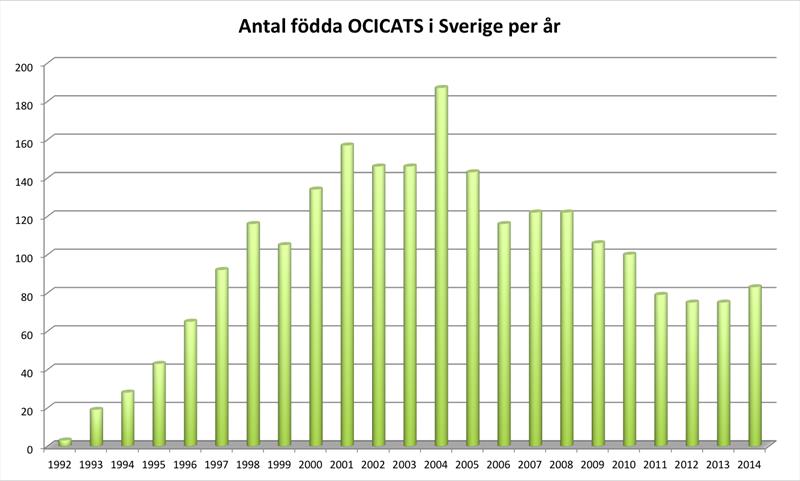Vad är ocicat?

Svartspottad ocicathona, SE*Alsmarks Dajkah. Foto: Madelene Jonsson 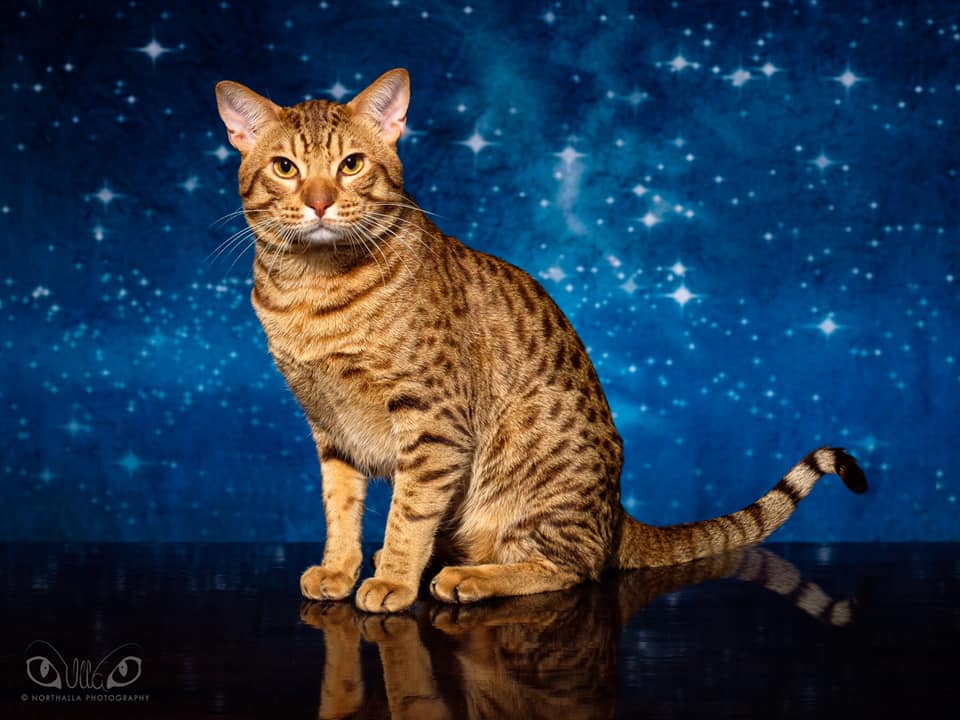
Chokladspottad ocicathane. FI*Moosegrove Romeo JR. Foto: Northalla Visuals 
Lilaspottad ocicathane, NO*Bakste Pus Darwin. Foto: Felida Foto 
Svartsilverspottad ocicathona, SE*Singers Star Girl. Foto: Madelene Jonsson 
An Ocicat at cat show, being judged. 
Cinnamon spotted Ocicat kitten, FI*Vinkeä Kaneli-Taneli
Ocikattens egenskaper
Ocikatter är aktiva, intelligenta och mycket sociala katter. De är lekfulla och idealiska för barnfamiljer under förutsättning att föräldrarna håller koll och lär barnen hur man hanterar katter. Många ocikatter uppskattar en kattkompis, särskilt en som har liknande sinne för lek och annan aktivitet. Mest idealiskt en annan ocicat!
Ocikatter är kommunikativa - de svarar på tilltal och de kallar på uppmärksamhet. Många ocikatter har ett karaktäristiskt nasalt eller lite knarrande läte, inte lika högt som många andra raser, men vissa individer är ganska snackiga - andra inte speciellt. Många ocikatter är väldigt tillgivna; vissa är knäkatter medan andra föredra att sitta bredvid; många följer sina människor överallt.
De är mycket lekfulla och om de inte får tillräckligt med stimulans kan det faktiskt bli frustrerande för dem och de kan hitta på oönskade sätt att aktivera sig på, som att t.ex. göra konfetti av toalettpappersrullen. Det är bra att känna till att ocikatter inte bara är någon dekorativt element i hemmet utan att de är familjemedlemmar med egna behov.
Om du är intresserad, kika på den här vetenskapliga studien av Milla Salonen om kattraser och skillnader i deras beteendedrag. https://www.nature.com/articles/s41598-019-44324-x I denna artikel studeras ocikatten som grupp tillsammans med abessinier och somali.
Ocikattens färger
There are 12 accepted Ocicat colors in FIFe. The only accepted pattern in spotted tabby. All Ocicat colors are caused by eumelanin granules in hair shafts. The “wild type” eumelanin produces black color, and there are also two variations of the gene B that dictates the eumelanin type. Variation b gives hairs a lighter shade that is brownish, and variation bl even lighter, reddish-toned color. The genotype of the cat defines the color as follows:
- Black (B -)
- Chocolate (b b, or b bl)
- Cinnamon (bl bl)
If the cat inherits the wild type gene B from one or both parents, the color of the fur will be black. Actually, the tabby pattern lightens how we see the color: the overall look of the spotted tabby cat that has black B gene is tawny/brown. The spots are dark brown to black and the underlying color is light brown. The gene B dominates over chocolate and cinnamon.
If the cat has inherited chocolate variation of the gene (b) from both its parents (or chocolate from one and cinnamon bl from another parent), the color of the cat is chocolate brown. The spotted tabby pattern again causes the chocolate color to be intensive on the pattern, and the underlying color is light brown, s bit warmer than on the tawny/black spotted cat.
A cat can only display cinnamon color if it has inherited the cinnamon variant of the gene from both parents (genotype bl bl). The color of the pattern is then cinnamon brown and the underlying color is very warm shade of light brown.
The dilution gene is responsible for color variations of blue, lavender, and fawn. The dilution gene is independent from the eumelanin gene variation. The dilution gene is recessive, so the cat needs to get one allele from both parents to show dilute color. With dilution, the black becomes blue, chocolate becomes lavender, and cinnamon becomes fawn. Now we understand six of the twelve Ocicat colors.
Then the silvers. A dominant (needs to be inherited from only one parent) inhibitor gene is responsible for making the base color white instead of light brown. The color of the pattern is a bit darker than it would appear without inhibitor gene. Inhibitor gene is inherited independently from eumelanin and dilution. With inhibitor gene, tawny spotted becomes (black) silver spotted, chocolate spotted becomes chocolate silver spotted, etc. Dilution silver spotted cats can sometimes be tricky to distinguish from dilution spotted.
In FIFe registers, the colors and patterns are marked with EMS codes (Easy Mind System). The relevant EMS codes for ocicats are:
- OCI, means the Ocicat breed
- n, black
- b, chocolate
- o, cinnamon
- a, blue
- c, lavender
- p, beige/fawn
- s, silver/smoke
- 24, spotted tabby
- 22, blotched tabby
- 25, ticked tabby
Examples:
- OCI n 24 = Ocicat, tawny (black) spotted tabby
- OCI os 24 = Ocicat, cinnamon silver spotted tabby
- OCI x c 22 = Ocicat, lavender blotched tabby (see below)
It can happen that sometimes two spotted tabby parents have kittens with blotched tabby pattern, or solid color (without pattern, except faint ghost pattern). When introducing more genetic material into Ocicats’ gene pool, Ocicats can be crossed with Abyssinians and the resulting kittens can have ticked pattern, resembling more Abyssinian than Ocicat. Ocicats with patterns other than spotted tabby, are marked in FIFe EMS codes with x, e.g. OCI x bs 22 (chocolate silver blotched tabby).
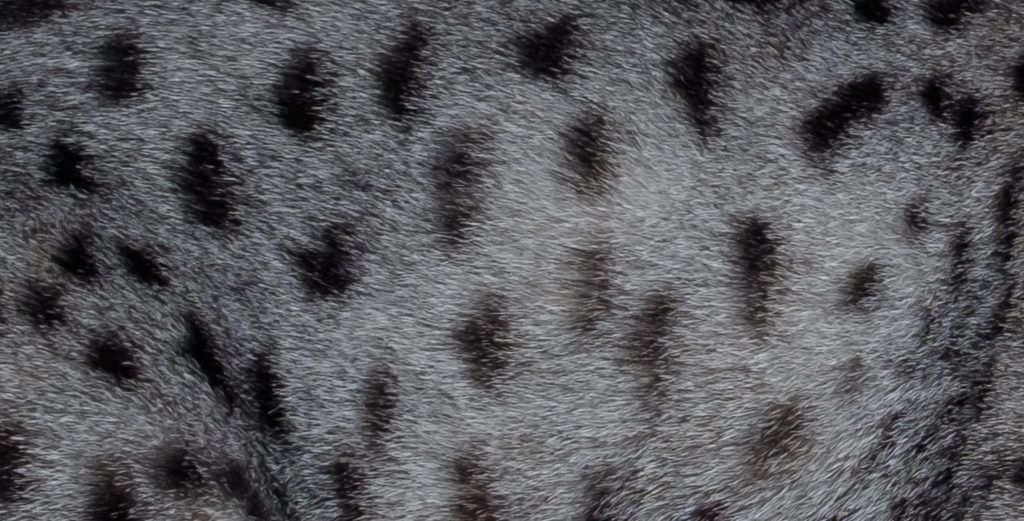
Ocicat breed standard
| General | Ocicat is medium to large, well-spotted agouti cat of moderate type. It displays the look of an athletic animal; well muscled and solid, graceful and lithe, yet with a fullness of body and chest. It is alert to its surroundings and shows great vitality. This powerful, athletic, yet graceful, spotted cat is particulary noted for its wild appearance. |
| Head | The skull is a modified wedge showing a slight curve from the muzzle to the cheeks, with a visible, but gentle ris from the bridge of the nose to the brows. The muzzle is broad and well defined with a suggestion of squareness and in profile shows good length. The chin is strong with a firm jaw with a proper bite. The whisker pads: moderate, whisker pinch is not too severe. |
| Ears | Alert, moderately large. When present, ear tufts extending vertically from the tips of the ears are a bonus. Placement: set so as to corner the upper, outside dimensions of the head. If an imaginary horizontal line is drawn across the brow the ears should be set at 45 degrees angle, i.e. neither too high not too low. |
| Eyes | Large, almond in shape, and angled slightly upwards towards the ears, with more than the length of an eye between the eyes. All eye colors except blue are allowed. There is no correspondence between eye color and coat color. Intensive color is preferred. |
| Neck | The head is carried gracefully on an arched neck. |
| Body | Rather long-bodied, solid, with depth and fullness but never coarse. Substantial bone and muscle development, yet with an athletic appearance. There should be some depth of chest with ribs slightly sprung. The back is level to slightly higher on the rear, and the flanks are reasonably level. |
| Legs | Medium long, of good substance and well muscled; powerful and in good proportion to the body. Paws: Oval and compact, with size in proportion to the legs. |
| Tail | Fairly long, medium slim with only a slight taper and with a dark tip. |
| Coat | Short, smooth and satiny in texture with a lustrous sheen; tight, close lying and sleek, yet long enough to accomodate the necessary bands of color. There should be no suggestion of woolliness and length. All colors should be clear and pleasing. The lightest color is usually found on the face around the eyes, on the chin and lower jaw. The darkest color is found on the tip of the tail. To determine the correct coat color, the color of the tail tip is decisive. |
History of the Ocicat
Text av: Jessica Lundgren
Den exotiskt fläckade katten som är känd för sin hundlika tillgivenhet den visar sin ägare, och som ser ut som en djungelkatt.
Ocicattens popularitet ökade snabbt och har satt sina tassavtryck i de flesta av världens länder.
Som Ni alla känner till, föddes den första ocicaten 1964 genom ett lyckligt misstag. Det var Virginia Daly "Dalai ocicats" som på 60-talet ville producera en abymaskad siames. Hennes plan att nå sitt mål var att para en abessinier med en siames, för att sedan para avkomman tillbaka på en siames.
På 50' och 60' talet var det mer accepterat med expe-rimentavel än idag. Andra experimentprogram Mrs Daly gjorde var siames & tabby hus-katt/siameshybrid som producerade ett par lyrix point siameser. En korsning av siames & calico huskatt/siameshybrid resulterade i pinto siames, och en havanna brown & lilamaskad siames resulterade i lila.
Resultaten av Mrs Dalys experimentavel producera-de 1950 Acfa' s första flamepoint siameshona till Grand Champion, och genom att korsa en röd per-ser med en siames; stammodern till de första ameri-kanska colorpoint perser. Senare fick hon fram GRC Dalai Jakki -USA:s bästa sealpoint siames 5 år i rad.
Men hennes största glädje var att avla med hybri-derna. (hybrid = avkomma av två olika raser) -Ofta repetitioner av andra uppfödares misstag. Hon ut-vecklade en ganska unik insikt i hur hon fick fram bästa kvalitén på dessa olika ungar och hon insåg inte att just en sådan här parning skulle resultera i en helt ny ras; ocicat.
Den ursprungliga linjen från Dalai ocicats började med en avkomma från en importerad abessinier champion med namnet Raby Chuffa of Selene. Man antar att det är denna hanen som gav kanel-genen (då kallad golden), till sin son Dalai Deta Tim of Selene, -en ruddy aby. Chuffa är också bakom många somalilinjer (somali = semilånghårig abessini-er), men lyckligtvis har ocicaten inte fatt det semi-långhårsanlaget -trots mycket linjeavel med denna linjen.
En ruddy aby valdes ut för att ironiskt nog fanns det ett fåtal, -om någon, röda abys i USA på den tiden att arbeta med i något avelsprogram. Tim parades med en sealpoint siameshona Dalai Tomboy Patter. Patter var en stor och kraftig siames, -även för 60-talets standard. Hela kullen såg ut som och var fenotypiskt abessinier.
The only female Mrs. Daly kept was Dalai She, a ruddy aby hybrid. Dalai She was paired with CH Whitehead Elegante Sun, called “Sunny”, a chocolate masked Siamese who himself was after an imported chocolate masked Siamese CH Kanhuri Hassan. Sunny was a large and well-muscled cat with a dark color. In the litter after Dalai She & Sunny was the long-awaited aby-masked Siamese, along with mackerel tabbys, a lynxpoint, a black, a classic tabby – and a gift from nature.
Denna "fula ankungen" var en vacker kanelspotted hane, -senare döpt till Tonga. Mrs Dalys dotter (även hon hette Virginia) tyckte Tonga såg ut som en ozelot och frågade om dom inte kunde kalla honom ocicat.
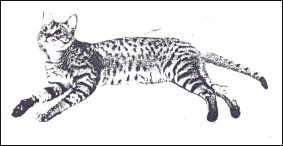
Denna kull född en frostig morgon 1964 i Michigan är den sanna starten av ocicatens historia. Början kunde också vara slutet. Tonga såldes som en säll-skapskatt med avtal om kastrering till en medicin-studerande Thomas Brown för 10 dollar. Tonga ställdes ut första gången 20-21 februari 1965 i De-troit som en speciell nyhet. Där var 16 st katter som ställdes ut som speciella nyheter, och i katalogen stod att läsa att dessa var framtidens raser. Så rätt de hade...
Senare kom Daly i kontakt med den välkända genetikers Dr Clyde Keeler vid Georgias universitet som var intresserad av uppfödare som ville producera en liknande katt som den utrotade egyptiska fläckade fiskande katten. Clyde föreslog att Tonga skulle para sin mamma Dalai She. Denna parning skedde aldrig. Men Dalys intresse hade vaknat att producera ocicats, och det blev hennes personliga mål.
Även om Tonga själv aldrig var med i avelsprogrammet upprepades parningen mellan Dalai She och Sunny som producerade Dalai Dotson, en brunspotted hane som Virginia använde som avels-hane. Dotson registrerades i CFA som ocicat och andra uppfödare såg därmed receptet (F2 aby x siames) och gick ett steg längre genom att introducera amerikanskt korthår, för dess substans och dess silvergen.
Katter värda att nämnas här var Serendip Silver Olivia (amerikanskt korthår x siames) och Dalai Maha Gony (amerikanskt korthår x abessinier). Andra intresserade uppfödare såsom Barbara Rounds "Darwin", Rita Marcuse "Aruby", Dr H.E. Beula Viergutz "Jobeuca" var bland de första att arbeta med ocicataveln.
Samarbetet producerade Darwin Vierdalai of Dalai som fick Dalai Golden Phoenix "Nikki" och Dalai Sequin, vilkas avkommor inkluderar GRC Dalai Golden Cavalier of Ociville, -CFA:s första ocicat Grand Champion och som finns i de flesta stamtavlor idag.
Mrs Daly lade sitt avelsprogram åt sidan när hennes moster blev sjuk, och mellan 1966 - 1980 registre-rades totalt bara 99 st. Ocicats International startade 1984 med 22 medlemmar. Under ledning av styrel-sen Virginia Daiy, Bill Mc Kee, Ann Hollier, Kaye Chambers och Aina DeBruhl godkändes raseri i USA 1988.
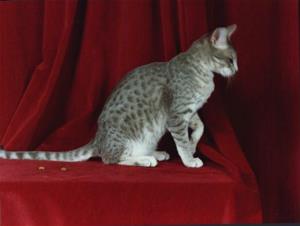
Nordens och Sveriges första ocicat kom till Göte-borg från England i december 1991: CH Lotsadots Chunky Blue, -en blåspotted hane och i januari 1992 kom Thickthorn Rosemary från England, -en svart-silverspotted hona. Paret importerades av Jessica Lundgren och de premiärvisades vid Boråskattens utställning i april 1992. De deltog inte i tävlan, efter-som de då fortfarande inte var godkända som ras i F--Fe, men de väckte stort uppseende däremot hos publik, utställare och press.
Ytterligare importer från England korn under 1992: Lotsadots Blue Angel, en blåspotted hona, GIC Thickthorn Bryony, -en brunspotted hona, C Thickthorn Chicory, -en brunspotted hane och. Thickthorn Polka Dot, -en brunspotted hona.
920601 blev Ocicat en godkänd ras inom FIFe.
921015 föddes Sveriges första kull ocicats: CH Halifax Hux Flux, CH Halifax Dainty Daisy, och EC Halifax Cheery Chap; -som var Sveriges första oci-cat att bli Best in Show och att erhålla titeln Europa Champion.
Statistik
Under 1993 registrerades 18 ocicats i Sverige och Norges 3 första ocicats importerades från Sverige: IC Halifax Hot Shot, Halifax Dina Isabella och GIC Halifax Mixie. 1993 importerade fan Stenroos Finlands första ocicats EC Gemlou Pink Panther, en lilaspotted hane och Gemlou First Lady-of-Galax, en kanelspotted hona.
Under 1994 registrerades 29 ocicats i Sverige och 5 i Norge. Under 1995 registrerades 54 ocicats i Sverige varav 8 var importer. I Norge registrerades 10 silvergen. st, och i Finland 35.
In 1995, 54 ocicats were registered in Sweden, of which 8 were imports. In Norway 10 were registered, and in Finland 35.
